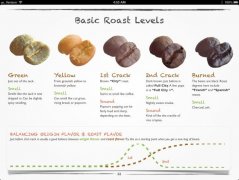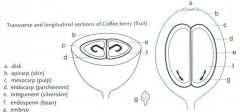Effect of different roasting degree on coffee flavor
In the career planning of baristas, with the increasing popularity of boutique coffee in recent years, coffee roasting has become one of the hot learning programs, and new occupations related to it have become more and more mature. Roasters, cup testers, and baristas seem to be three independent occupations. but they have something in common. In addition to the inherent quality of raw beans, the taste of coffee mostly depends on roasting. The damage to taste caused by incorrect baking technology can not be remedied by good grinding and extraction technology.
Light baking (Light Roast) / cinnamon baking (Cinnamon Roast)
[shallow baking]
This baking degree highlights the sour taste, so it has not been popular recently. "light roasting" is when coffee beans are roasted to near the first burst period; "cinnamon roasting" is roasting to about the middle of the first burst period.
The difficulty of this baking degree is not only to emphasize the sour taste, but also to remove astringency and wrinkles, so it is best to use astringent high-mature, highly refined Caribbean coffee beans such as Cuba, Haiti or Dominica.
In other words, this baking degree is most suitable for lowland coffee beans with thin pulp and low moisture, and can also be applied to coffee beans that are ripe for more than two years and have just the right degree of dryness.
Medium baking (Medium Roast) / high baking (High Roast)
[medium baking]
"medium roasting" refers to the roasting of coffee beans until the end of the first burst period, while "high baking" refers to baking until the coffee beans are wrinkled and the aroma changes.
This baking degree is suitable for Caribbean coffee beans with low moisture content, or Brazilian coffee beans that are naturally dried. Medium-and low-lying coffee beans, which lack a thick flavor, are more suitable for this roasting degree than highland coffee beans with multi-layered flavors such as Colombia or Kenya.
This roasting degree will make the coffee beans give off the flavor and aroma of coffee.
Urban baking (City Roast) / deep urban baking (Full-city Roast)
[medium and deep baking]
This roasting degree makes Americans who originally prefer light roasting like it, and almost all Italian espresso (Espressso) also use this roasting degree. Not bitter, not sour, this roasting degree can best make the coffee show a multi-level flavor.
"Urban roasting" is the stage of roasting coffee beans until the second stage of bursting, while "Deep City Baking" is the stage of roasting to the end of the second stage of bursting. It is suitable for coffee beans with strong characteristics, such as Manning, Hawaii, Cana and so on.
French baking (French Roast) / Italian baking (Italian Roast)
[deep baking]
"French Roast" is to make coffee beans a little brown in black, while "Italian roasting" is to roast coffee beans to an all-black state.
The bitter taste is obvious, the taste is simple, and some beans are smoky, which is suitable for highland coffee beans with thick pulp and strong sour taste, such as Kenya, Colombia, Guatemala and so on.
Although Italian baking is called "Italian baking", the baking degree of Italian Espressso is becoming more and more shallow, and recently it is more often used in urban baking or deep city baking.

Important Notice :
前街咖啡 FrontStreet Coffee has moved to new addredd:
FrontStreet Coffee Address: 315,Donghua East Road,GuangZhou
Tel:020 38364473
- Prev

Six skills and methods of roasting high-quality coffee
After writing, I found that the most difficult thing to talk about coffee roasting is the different understanding of the terms used to describe roasting. I will keep explaining the reason and purpose of using this concept. I try to avoid being polite and give practical information directly. Coffee roasting is an extremely complex process, but we can grasp it by three reference variables. Caramelization value: deep and shallow maturity: over and below
- Next

Summary of the conversion rate of cooked beans in the training and teaching of coffee roasters
Every coffee bean should be cherished. There is such a set of data: a coffee tree can pick 3-5 kilograms of coffee fruit a year. After complex processing, it can only get parchment coffee, which accounts for 5 pounds of coffee fruit. The processing plant with better drying rate can probably get more than 5 rough processed beans. The conversion rate from seed to ripe bean is about 5 kg fruit = 1 kg.
Related
- Beginners will see the "Coffee pull flower" guide!
- What is the difference between ice blog purified milk and ordinary milk coffee?
- Why is the Philippines the largest producer of crops in Liberia?
- For coffee extraction, should the fine powder be retained?
- How does extracted espresso fill pressed powder? How much strength does it take to press the powder?
- How to make jasmine cold extract coffee? Is the jasmine + latte good?
- Will this little toy really make the coffee taste better? How does Lily Drip affect coffee extraction?
- Will the action of slapping the filter cup also affect coffee extraction?
- What's the difference between powder-to-water ratio and powder-to-liquid ratio?
- What is the Ethiopian local species? What does it have to do with Heirloom native species?

